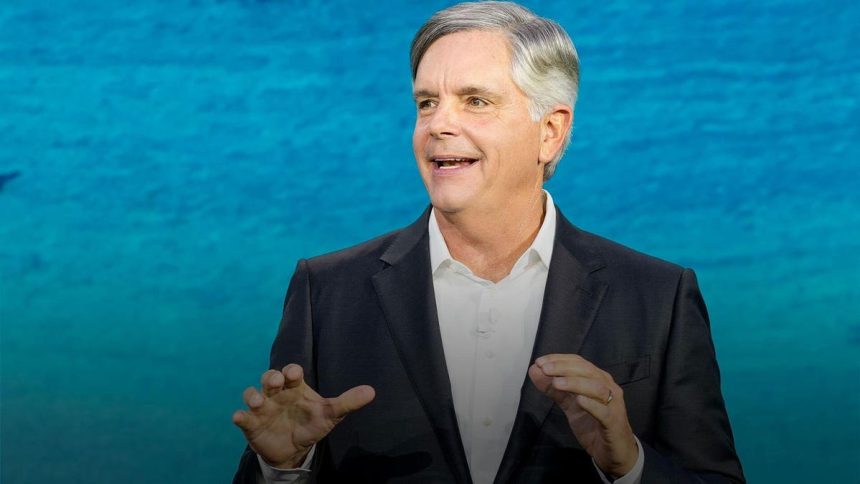Meet the lean-obsessed leader who broke up GE and changed its playbook on how to win.
By Diane Brady
To understand how Larry Culp has reshaped GE during his five years as chairman and CEO, consider the star-studded event that he hosted in Manhattan on September 6. The goal was not to promote new products but rather a decades-old business philosophy called “lean” that draws on Japanese manufacturing techniques.
Uber CEO Dara Khosrowshani and Ford CEO Jim Farley cheerfully swapped stories about their rambling gemba walks to experience company challenges firsthand. Chef Wolfgang Puck and filmmaker David Gelb talked about bringing the continuous improvement known as kaizen to the kitchen. PG&E CEO Patti Poppe shared how lean thinking could save lives, as did U.S. Navy Admiral William Lescher, Cleveland Clinic’s Tomislav Mihaljevic and New York City Fire Commissioner Laura Kavanagh. Their faces also adorned the illustrated Lean Mindset tote bags that attendees were encouraged to fill with a selection of free books on lean-related topics.
And what about Henry Lawrence Culp, Jr, our host and lean ambassador who first embraced its principles as a young manager at The Danaher Corporation? After he became Danaher’s CEO in 2000, at around the same time that GE announced Jeff Immelt would replace Jack Welch as CEO, the Kaizen-obsessed Culp went on to quintuple Danaher’s revenue and market cap before retiring to teach in 2014. Did he not want to share a few nuggets about his struggles in bringing a lean mindset to the company that put Six Sigma on the map?
Nope. GE’s first-ever outside CEO instead played the role of interviewer, quizzing former NFL quarterback Peyton Manning about lean teams, psychologist Carol Dweck about the growth mindset and NBA star Giannis Antetokounmpo about continuous improvement. Peter Arduini, CEO of the newly public GE HealthCare, also served as a moderator–as did GE Vernova CEO Scott Strazik.
After years of underperforming shares and accumulating debt, General Electric is in the midst of a major restructuring that will split the 131-year-old bemouth (2022 Sales: $76.6 billion) into three separate public companies: GE Aerospace, GE HealthCare and GE Vernova (energy). The first of the three, GE HealthCare was fully spun-off in January and now trades on the Nasdaq as GEHC with a market cap of $29.5 billion. Aerospace and Vernova will separate next year. Culp is also CEO of Aerospace, which essentially is all that will be left of the old GE after the spinoffs.
When asked why he would host a leadership forum on lean and not talk about his own journey in creating a leaner GE, Culp looked at me as if I’d come unprepared to class. I’d clearly forgotten the first pillar of lean management: lead with humility. “We thought the best way to answer those questions was to gather a number of like-minded practitioners from a range of different industries,” says Culp. “We covered the NFL all the way to Wolfgang Puck to help everyone understand what the core principles are and what they look like in action.”
Maybe a man who looks at a factory floor like it’s a crime scene would also look at a two-time Super Bowl champion and wonder about his process for continuous improvement. With his somber suit and professorial air, Culp comes across less like a captain of industry than a cross between Agent Smith from “The Matrix” and the best damn doctor in town. You wouldn’t want to mess with him in the boardroom but he’ll diagnose what’s wrong and get you back on your feet.
A company known for celebrity CEOs is now led by a man who uses words like ‘circumspect’ and ‘unpretentious’ like they’re good qualities to have in a leader. Having looked at hundred of companies over this career, Larry Culp knows what it takes to be a high performer. He doesn’t need to talk to reporters to get the job done. His approach was shaped at the publicity-shy Danaher, not at a media darling that trumpeted its importance to the world. While Culp speaks almost reverentially about GE’s talent system that made it a farm team for future CEOs, he didn’t go looking for things to preserve. “There were, let’s just say, plenty of opportunities for improvement,”
End Of An Era?
Fixing GE was no easy task. Immelt had radically overhauled the business during his 16-year tenure, selling off units like plastics, appliances, media and financial services to focus on fast-growing industrial businesses. He embraced lean methods, too, even creating a program around them. But that couldn’t counter the impact of overpriced acquisitions, mounting debt and an apparent allergy to delivering bad news. By the time Immelt left in June 2017, the celebrated, AAA-rated GE he’d inherited was a mess. GE veteran John Flannery tried to right the ship but lasted just over a year—during which the last original member of the Dow was kicked out of the blue-chip index.
Culp came in and slashed jobs, debt and business units. He cut GE’s famously generous dividend to a penny per share. But he also struggled to the point where the board canceled stock awards originally valued at $20 million in 2022 after he didn’t hit his targets. But things are looking up, with GE beating expectations with second-quarter earnings per share of 68 cents. As of September 8, its share price is up more than 68% this year.
Still, Culp’s distaste for promoting the sizzle and showmanship that made GE stand apart has made some folks feel a little wistful. “Ask him why he had to break it up,” says one GE HealthCare customer as he picks through a bento box lunch at the September 6 event. “GE stood for something greater than the sum of its parts. If they’d held this thing at Crotonville, it would feel like you’re getting something special from GE.”
Conversations about lean production methods do feel less suited to a hip warehouse space in Chelsea than GE’s famed Crotonville center on the Hudson River, where generations of managers had honed their skills since 1956. But the sprawling corporate campus is being sold, a relic of an era when GE itself was a sprawling conglomerate, by turns the largest, the most valuable and the most revered company on the planet.
Thomas Edison may have created the incandescent bulb that made GE a household name but Jack Welch created the strategies that made GE the rock star of corporate America and Welch the revered leader of the band. With his bombastic charm, pithy quotes on leadership [“Cut the bottom 10%!”], and unapologetic focus on maximizing shareholder value, Welch turned a blue-chip conglomerate into a fast-growing giant that turned out TV shows, aircraft engines, power turbines, porta potties, credit cards, scanners, plastics and money–lots and lots of money from GE Capital, a unit that essentially became the world’s largest unregulated bank.
Having started life as a financing unit to help customers buy dishwashers and the like, GE Capital became a multi-tentacled beast that made $96 billion in revenue in 2000, but was reported as a single line item in GE earnings reports. That made it hard to know how GE made its money but easy to understand the flexibility it gave to a leader who consistently delivered on earnings expectations to the penny. When Welch walked into the CEO job in 1981, GE’s stock price was trading at $2.38. By the time he walked out about two decades later, a GE share was worth close to $136, giving Welch an aura of genius that stayed remarkably intact until his death in 2020.
Immelt doubled down on that grow-big-and-follow-the-money strategy — but in a very different environment. After taking over within days of 9/11, Immelt had to grow GE in an era where scandals and financial crashes brought more regulation, transparency, scrutiny and skepticism. Ultimately, that may have helped in turning the golden child of capitalism into a company brought down by debt, dysfunction, disarray and disillusionment.
“We needed to drive not only better profitability, better cash for our investors, but better safety, quality delivery, and productivity performance for our own team, let alone for our customers,” says Culp. “And the best way I know to do that is through a lean mindset.”
And did he really have to break it up to get there? “It’s been less about GE,” says Culp. “It really is, I think, a natural evolution … the businesses will continue to share the brand, they’ll use the monogram. Coupled with a lean mindset, I think we’re going to serve these businesses exceptionally well for at least another 131 years.”
Maybe so but that GE HealthCare customer who’s picking through his bento box isn’t alone in wanting a bit of the old glamour back, too. His colleague was excited by the lineup of superstars that GE brought together to praise lean. What surprised her was the lack of attention to GE. “I’m curious to hear how they’re doing,” she says, leaning on her free copy of “Good to Great,” Jim Collins’ 2001 bestseller on what it takes for businesses to have staying power at the top. It’s a telling symbol for a company—make that three companies—that still want to be No. 1. What matters most to her is not the person at the top but the product on the ground. If a leaner, smaller company gets that done, Culp’s mission will have paid off.
MORE FROM FORBES
Read the full article here









